

(Glogster)Writing Classroom: text, images, music, video (Nyrie) FigurativeLanguageAnchorChart (Amber) Tackling research infographic. The Easy Step-by-Step Guide to Making Infographics from Scratch. Step 2 If there’s one thing that makes an effective infographic, it would have to be nailing your research.
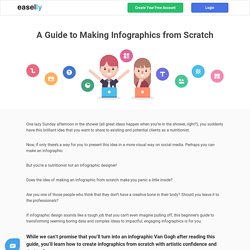
It’s not uncommon to kill a great idea or a concept for an infographic because of the lack of reputable sources and relevant data. The good news is that there is no shortage of data these days on the Internet. My Top 10 Sketchnotes in 2016. As the clock ticks down to the end of 2016, it’s a perfect time to reflect on the past 12 months.

I derive a huge pleasure in creating drawings related to education and then sharing them on social media. A question I often get is, “What are your most popular sketchnotes?” Well, thanks to Twitter, it’s easy to get hard statistics to find out the answer. So here they are, in order from 10 to 1. Using Anchor Charts in Middle and High School: Why and How. Fiction and Nonfiction Mini Lessons (Meg Pettigano) Share on StumbleUpon0 shares on StumbleUpon Teaching little readers the difference between fiction and nonfiction text is important, fun, and interactive!

In addition to identifying whether a text is fiction or nonfiction with everything we read throughout the year as a class and during small group lessons (after all, repetition is a brain-based strategy), I also complete three staple “mini-lessons” with my students. (LuAnn) Firsthand Secondhand Accounts Anchor Chart (Courtesy of teachingwithamountainview.com) Untitled.
Angela Giles - ELA Anchor Charts: Just Right Books. Zen presentation takeaways (VI.C.2) (1) Haley James - Story Themes Anchor Chart. Chrissy H. - "I PICK" Bookmarks. Guided Inquiry Design Process - Jessica Eschbach. Yesterday I attempted to discuss this wiggly topic of how GID is not lockstep.
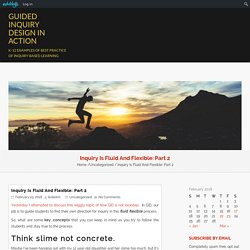
In GID, our job is to guide students to find their own direction for inquiry in this fluid flexible process. So, what are some key concepts that you can keep in mind as you try to follow the students and stay true to the process. Think slime not concrete. Maybe I’ve been hanging out with my 12 year old daughter and her slime too much, but it’s not a bad mental image for the difference between flexibility and rigidity. Slime vs Concrete Being flexible takes deep understanding of the process. Know the phases. Knowing the process phases and the intention of each phase help s you to know when we are ready to move on.
Know the research. The more you understand the research behind GID, the more fluid and flexible you can become, in the moment. (Ana) Ms. Third Grade: August 2013. It's day 3 of Teacher Week and today is all about organizing our classrooms!
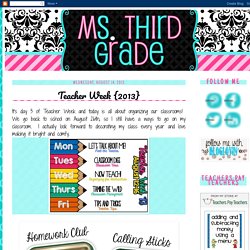
We go back to school on August 26th, so I still have a ways to go on my classroom. I actually look forward to decorating my class every year and love making it bright and comfy. Does your classroom library need a little organization? Then this is perfect for you. I have included 54 labels for book bins for an elementary classroom library. Genres: holidays, mystery, solar system, poetry, science, weather, holidays, biography, trains, dinosaur, history, and many more! Authors: Judy Blume, Louis Sachar, Roald Dahl, Beverly Cleary, Andrew Clements, Jerry Spinelli, and many more! Series: I Survived, American Girls, Wayside School, Stink, Geronimo Stilton, Boxcar Children, Babysitter's Club, Magic Tree House, and many more!
Five finger rule – (Gale C.) Hello Friends!
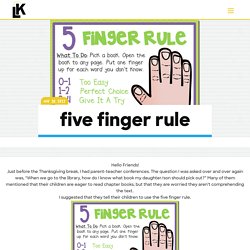
Just before the Thanksgiving break, I had parent-teacher conferences. The question I was asked over and over again was, “When we go to the library, how do I know what book my daughter/son should pick out?” Many of them mentioned that their children are eager to read chapter books, but that they are worried they aren’t comprehending the text. I suggested that they tell their children to use the five finger rule. I’m sure many of you’ve heard of this before. Stop Think and Jot. This point of view blog post outlines point of view activities for first grade, second grade, third grade, and fourth grade. The blog … Teacher Stuff: It’s Chart Day!! – Skinned Knees & Shoelaces (Holly) I LOVE making charts!

Step into my classroom and you’ll probably say, “Wow, someone has too much time!” But to be honest, I don’t! I just love them so much and love the way they are useful but can add so much character (sometimes literally) to our walls. They help the kids remember stories, access words they’ve learned, or recall tools to help them organize their thinking. I have found that the kids, especially little ones, use and remember more from the charts when they are very visual, so I make time in my week to create these charts using characters from the stories, pictures to illustrate a poem or concept, and bright colors.
Let’s start with the charts I made for the week we were practicing Retelling using familiar stories. On the first day, we discussed the elements of James Marshall’s Red Riding Hood and worked together to write a summary of the story. Books We Used: Teaching With a Mountain View: Analyzing Firsthand and Secondhand Accounts (Ariel Richvalsky) Compare and contrast a firsthand and secondhand account of the same event or topic; describe the differences in focus and the information provided.
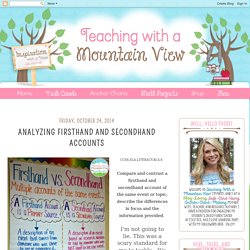
I'm not going to lie. This was a scary standard for me to tackle. Fiction or Non-Fiction? (Fran Kyrtatas) Just a quick post today. . .
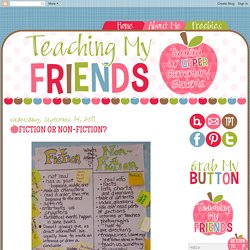
This was a bit of a combo lesson I did earlier this year. We first brainstormed the differences between fiction and non-fiction. My friends did pretty well, but it was a bit surprising to see what they missed. I think in all, the last bullet in each column was one they hadn't really thought about before. We had talked about genres briefly a few days prior, so I added it on to our lesson. Chris Lainson Citing Sources - Waupaca High School Instructional Media Center.
Copyright and Fair Use (Christina B.) RACE Writing Strategy Response Poster (Jill) ***Check out this product that includes MORE posters, bookmarks, and a writing response sheet for both RACE and RACES - only $2.00 more!
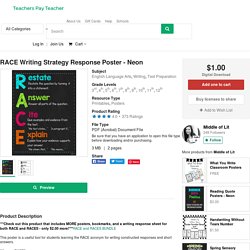
***RACE and RACES BUNDLE This poster is a useful tool for students learning the RACE acronym for writing constructed responses and short answers. Top 10 Characteristics of a Literacy-Rich Environment (Kathleen B.) Can I Use that Picture? Revised and Simplified! (Amy) Non Fiction Text Features Anchor Charts (Kathryn B.) Folk Tales Anchor Chart (Kathryn B.) Future Ready Librarians. NJ Learning Standards. AASL Standards Crosswalk ISTE (Christina Williams) Edutopia (Christina Williams)
Begin With Guided Inquiry Teacher-guided inquiry can build background knowledge of the topic before letting students take the reins in developing their own inquiry. With guided inquiry: Teachers start with an overall guiding question. Teachers know what they want their students to understand beforehand. Students know what the outcome of the inquiry will be. "Guided inquiry is like a typical science lesson," explains Anne DiCola, Ralston Elementary's instructional coach.
Ralston teachers build toward student-driven inquiry throughout the course of the unit. What gets a capital letter? (Mary Kate) Reading. Writing. Thinking. Sharing. (From Karen) How are you doing with teaching non-fiction, informational texts? Do you feel you have a good grasp on expository text structures? With the Common Core ELA standards, students are expected to be proficient in reading complex informational texts. State assessments are also becoming more non-fiction focused, to evaluate student abilities in navigating these complex texts.
Book talk anchor chart - MCJ. Digital Citizenship Poster for Elementary Classrooms (from Beth) Teaching Diversity with Kids. Jennifer James www.kiddiematters.com. THINK before you post - Jazz. Finding Main Ideas - Richelle DeFrank. Steps for Research Anchor Chart (Sarah T.) Anchor Charts 101: Why and How to Use Them, Plus 100s of Ideas (Jenna M.) Spend any time browsing teacher pages on Pinterest and Instagram, and you’ll run across hundreds of ideas for classroom anchor charts. But you may have lingering questions about what they are, what purpose they serve, how to get started, and when to use them. Have no fear! WeAreTeachers has created this primer to inform you, and we’ve also included a huge list of resources to get you started. We have a feeling that once you get started, anchor charts are going to your new favorite thing.
Fiction and Non-Fiction Anchor Chart by The Book Fairy Goddess. Teaching the difference between Fiction books and Non-Fiction books is an important skill, especially in the younger grades. In the past, I’ve always created a poster on chart paper with the information along with the students. Sometimes, in my rush, my poster had mistakes or was not the neatest as I must have missed the day they handed out the “teacher handwriting gene”! That always bugged me, because I would refer back to the poster for several weeks. So I decided to create an anchor chart that I could BUILD with the students, but have the pieces already printed out, including cute graphics to help my kindergartners know what the words were. Analyzing Firsthand and Secondhand Accounts (Ben) Compare and contrast a firsthand and secondhand account of the same event or topic; describe the differences in focus and the information provided.
Ross's Guide to Socratic Seminars (Lisa R.) Copy of Inquiry Learning Circle by Sarah Martyn on Prezi. Next Gen Makerspaces: NGSS & Makerspaces - Worlds of Learning. Judging a Book. Reading Infographic Final. Six Shift Infographic Final. Infographic: Technology maximizes Common Core success. Inquiry Infographic Final. Stretch Your EdTech Practice.
Educator ISTE Standards. 36 Core Teacher Apps For Inquiry Learning With iPads. Lisa S. Pinterest Board. How to Cite Textual Evidence in MLA Format - Digital Anchor Chart (Allison) Help your students learn the basics of citing textual evidence in their literary writing with this digital anchor chart. 6 Ways to Make Your Library Program Future Ready (Anina) What’s New in the Eighth Edition. The eighth edition of the MLA Handbook, published in 2016, rethinks documentation for an era of digital publication. The MLA now recommends a universal set of guidelines that writers can apply to any source and gives writers in all fields—from the sciences to the humanities—the tools to intuitively document sources. Learn more below about the changes to MLA guidelines. Get resources for teaching, an FAQ, tips on writing, and more on The MLA Style Center.
The List of Works Cited. CRAAP Test - EHS Library (Gina Policastro)
We use this in our high school, too. Thanks for helping me re-imagine it as an anchor chart possibility! – lsteel715
A Peek into our Nonfiction Research and Research Based Argument Essay Unit. Makerspace Anchor Chart (Rebecca S.) Webpage Analysis Infographic (Taylor) Note Taking Anchor Chart (Kate-Lynn) How to annotate (Erin H) Mindset – Jedi Edition #July2014Challenge. Telling Time Anchor Chart (Christina C.)